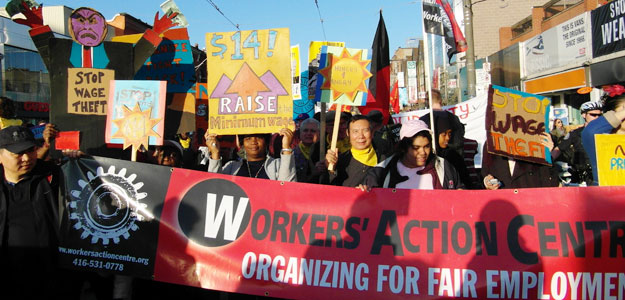by Martin Cooke
“We asked people working minimum wage jobs what they thought the minimum wage should be,” said Deena Ladd over the phone.
Deena Ladd is an organizer with the Workers Action Center in Toronto. In 2013, the Workers Action Center starting organizing to raise the minimum wage in Ontario.
The coalition was able to reach out to groups in over 15 cities throughout the province of Ontario throughout 2014. They met with working people to come up with a set of principles to determine the minimum wage.
“Together, we looked at how the price of living had increased, yet the minimum wage had stayed at $10.25.”
They agreed that the minimum wage should bring workers and their families out of poverty. The minimum wage should be set 10% above the poverty line. The minimum wage should also be updated every year with the cost of living. (Four other provinces and territories have already adopted this policy: Alberta, Newfoundland, Nova Scotia, and Yukon).
Based on their principles, the coalition agreed to fight to raise the minimum wage to $14 per hour.
For their first action, they invited their members to freeze $10.25 in a block of ice and deliver it to their provincial representatives.
Every 14th of the month, the coalition organized new actions throughout the province. They made the actions exciting and accessible for people with various levels of political experience.
“Our actions were covered in the small town newspapers and talked about on the radio,” said Ladd.
“Because our members were people working minimum wage jobs, they were great spokespeople. They spoke about their own hardships. They could tell anyone why the minimum wage needed to be increased.”
Beyond the grassroots, the campaign received a boost from professionals like doctors and nurses who testified about the adverse effects for health of living below the poverty line and the need to raise the minimum wage.
As the campaign gained momentum and press coverage, businesses and the provincial government got scared. Rather than be divided, the coalition would continue to organize to put pressure on the government.
Businesses also tried to manipulate the public opinion and Ladd stressed the importance of having vocal small business owners on board.
After one year of organizing, the coalition was able to force the government to unfreeze the minimum wage and to agree to index the minimum wage to inflation.
Unfortunately, the Liberal government only raised the minimum wage by ¢75 as the NDP opposition was silent when it was time to ask for more. The coalition was extremely disappointed by the NDP’s inaction at a crucial moment, and they took to calling the leader of the NDP to criticize them. Perhaps as a result of this pressure, the NDP has now put forward a call to raise the minimum wage to $15 – but only after the Liberals took a majority in Ontario and so only after it became easier to take a hardline from the sidelines.
Deena Ladd says that the Workers Action Center is continuing to organize and fight to raise the minimum wage for people throughout the province.
Comments
